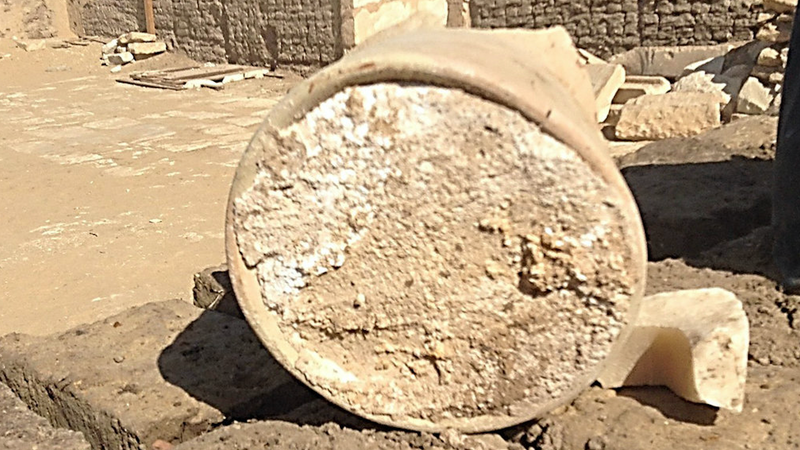Humans have been producing and consuming cheese for a very long time, as the recent discovery of 3,200-year-old cheese in an ancient Egyptian tomb attests. Delicious though this cheese may have been, it was also a potential source of disease.
New research published this week in the science journal Analytical Chemistry describes what is “probably the most ancient archeological solid residue of cheese ever found to date,” in the words of the study’s authors. Dating back to the 13th century BC, the “solidified whitish mass,” was discovered in a jar, and despite 30 centuries of exposure to harsh desert conditions, the compound retained enough of its original chemical content for scientists to study its cheesy origins. In addition to determining the kind of animal milk used to manufacture the cheese, the researchers also detected traces of a dangerous bacteria that still plagues us to this very day.
The tomb containing the jar of cheese was originally discovered in 1885, but promptly forgotten and subsequently lost after Saharan sands enveloped the archaeological site. It wasn’t until 2010 that the site was re-discovered and re-examined by French archaeologists. Grave robbers had already swept through the tomb, but a batch of pottery jars (many broken), including one containing the cheese and a canvas cloth, were ignored by the looters.
The jar containing ancient cheese was buried alongside Ptahmes, the mayor of the sprawling Egyptian city of Memphis, the capital of Lower Egypt at the time. The site dates back to the 19th Dynasty, which ruled over Egypt from 1292 BC to 1189 BC. As a political figure, Ptahmes was a big deal; in addition to his mayoral duties, he worked as the military chief of staff and he oversaw the city’s treasury. Upon his death, Ptahmes’ status was elevated to High Priest of the god Amun, an early Egyptian deity. And as the new study points out, he may also have had a thing for cheese.
Nearly 33 centuries of exposure to the strong alkaline desert environment altered the chemical nature of the sample (particularly its fatty content), making analysis of the white substance difficult. To study the alleged cheese, a team led by Enrico Greco of the University of Catania in Italy had to devise an entirely new way of analyzing proteins and identifying peptide markers (short chains of amino acids that signal the presence of specific substances). After dissolving bits of the white mass, Greco’s team isolated and purified protein samples. The proteins were carefully analyzed using mass spectrometry and liquid chromatography. Despite the years of decay, the researchers were still able to identify specific peptide markers, identifying the substance as a type of hard cheese.
Analysis showed that the dairy product was produced by mixing milk from goat, sheep, and, strangely, African buffalo—a species not typically associated with domestic animals kept and milked in modern Africa. Analysis of the canvas cloth showed it was good for holding solid, and not liquid, substances; this cloth was likely used to cover the cheese, or the possibly the top of the jar.
But the researchers also found peptide markers consistent with Brucella melitensis—a bacterium that causes brucellosis. Not surprisingly, this cheese was unpasteurized, making it a potentially dangerous, albeit tasty, food.
“The most common way to be infected [with Brucella melitensis] is by eating or drinking unpasteurized/raw dairy products. When sheep, goats, cows, or camels are infected, their milk becomes contaminated with the bacteria,” explains the U.S. Centers for Disease Control at its website. “If the milk from infected animals is not pasteurized, the infection will be transmitted to people who consume the milk and/or cheese products.”
Brucellosis isn’t typically fatal, but it is nasty. Symptoms include fever, night sweats, malaise, and muscle pain, with long-term health issues including arthritis, swelling of the testicles, chronic fatigue, and endocarditis (swelling of the heart), among many other conditions. Previous archaeological evidence has shown that ancient Egyptians were no stranger to brucellosis, with the new discovery providing further evidence of this infection, and its means of transmission via infected cheese, during this period.
As for how the cheese tasted, it would have had a similar consistency to chevre, but with a “really, really, acidy” bite, Paul Kindstedt, a professor at the University of Vermont, told the New York Times, adding that, it “would be high in moisture; it would be spreadable.”
Writer and Artist of "Thor" Talk About The Comic
Wednesday 11:03am
Sounds good to me! Except for that whole Brucella melitensis thing. Definitely don’t like that part.
end quote from:


No comments:
Post a Comment